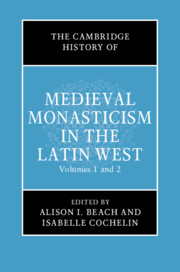Book contents
- The Cambridge History of Medieval Monasticism in the Latin WEST
- The New Cambridge History of Medieval Monasticism in the Latin West
- The Cambridge History of Medieval Monasticism in the Latin WEST
- Copyright page
- Contents
- Figures
- Contributors
- Acknowledgments
- Abbreviations
- 1 General Introduction
- Part I The Origins of Christian Monasticism to the Eighth Century
- Part II The Carolingians to the Eleventh Century
- Part III The Long Twelfth Century
- 34 Historiographical Approaches to Monasticism in the Long Twelfth Century
- 35 Sources for Monasticism in the Long Twelfth Century
- 36 Hermitism in the Eleventh and Twelfth Centuries
- 37 Monastic Theologies, c. 1050–1200
- 38 Monastic Preaching and the Sermon in Medieval Latin Christendom to the Twelfth Century
- 39 The Mass in Monastic Practice: Nuns and Ordained Monks, c. 400–1200
- 40 Reclusion in the Middle Ages
- 41 Similarities and Differences between Monks and Regular Canons in the Twelfth Century
- 42 The Institutionalization of Religious Orders (Twelfth and Thirteenth Centuries)
- 43 Gender and Monastic Liturgy in the Latin West (High and Late Middle Ages)
- 44 Monastic Landscapes
- 45 Later Monastic Economies
- 46 Nobility and Monastic Patronage: The View from Outside the Monastery
- 47 The Medical Role of Monasteries in the Latin West, c. 1050–1300
- 48 East-Central European Monasticism: Between East and West?
- 49 Monasticism, Colonization, and Ethnic Tension in Late Medieval Ireland
- Part IV Forms of Monasticism in the Late Middle Ages
- Index
- References
40 - Reclusion in the Middle Ages
from Part III - The Long Twelfth Century
Published online by Cambridge University Press: 16 January 2020
- The Cambridge History of Medieval Monasticism in the Latin WEST
- The New Cambridge History of Medieval Monasticism in the Latin West
- The Cambridge History of Medieval Monasticism in the Latin WEST
- Copyright page
- Contents
- Figures
- Contributors
- Acknowledgments
- Abbreviations
- 1 General Introduction
- Part I The Origins of Christian Monasticism to the Eighth Century
- Part II The Carolingians to the Eleventh Century
- Part III The Long Twelfth Century
- 34 Historiographical Approaches to Monasticism in the Long Twelfth Century
- 35 Sources for Monasticism in the Long Twelfth Century
- 36 Hermitism in the Eleventh and Twelfth Centuries
- 37 Monastic Theologies, c. 1050–1200
- 38 Monastic Preaching and the Sermon in Medieval Latin Christendom to the Twelfth Century
- 39 The Mass in Monastic Practice: Nuns and Ordained Monks, c. 400–1200
- 40 Reclusion in the Middle Ages
- 41 Similarities and Differences between Monks and Regular Canons in the Twelfth Century
- 42 The Institutionalization of Religious Orders (Twelfth and Thirteenth Centuries)
- 43 Gender and Monastic Liturgy in the Latin West (High and Late Middle Ages)
- 44 Monastic Landscapes
- 45 Later Monastic Economies
- 46 Nobility and Monastic Patronage: The View from Outside the Monastery
- 47 The Medical Role of Monasteries in the Latin West, c. 1050–1300
- 48 East-Central European Monasticism: Between East and West?
- 49 Monasticism, Colonization, and Ethnic Tension in Late Medieval Ireland
- Part IV Forms of Monasticism in the Late Middle Ages
- Index
- References
Summary
Reclusion was a very common type of religious life in the medieval West, especially in the high Middle Ages. A man or a woman was voluntarily confined within a narrow space and lived there alone, consecrating the rest of their life to prayer. If Rome outshone any of its rivals with its 230 recluses at the beginning of the fourteenth century, it seems that most cities or towns were home to at least one recluse. By the end of the Middle Ages, however, reclusion had become rarer in some regions—for instance, in Italy from the thirteenth century, in Spain from the fifteenth century—while a significant number of recluses were still established in Germany and England at the beginning of the sixteenth century. After the Reformation, reclusion was prohibited in Europe even as it was already waning everywhere. By the seventeenth and eighteenth centuries, historians, including Mabillon, could refer to the recluse as an extinct species.
- Type
- Chapter
- Information
- The Cambridge History of Medieval Monasticism in the Latin West , pp. 747 - 765Publisher: Cambridge University PressPrint publication year: 2020
References
- 1
- Cited by



